Index
Review: Silent R9 290 with R9 290X power
Today we’ll take a closer look at the flagship R9 290 card from PowerColor. The full name of the card is PowerColor PCS+ R9 290 4GB GDDR5, with the part number AXR9 290 4GBD5-PPDHE. It uses nicely designed, but oversized three-fan cooler and a custom PCB. The cooler was originally designed to meet the demands of the more powerful R9 290X. We hope this should provide more silence and overclocking headroom for the PCS+ R9 290 card.
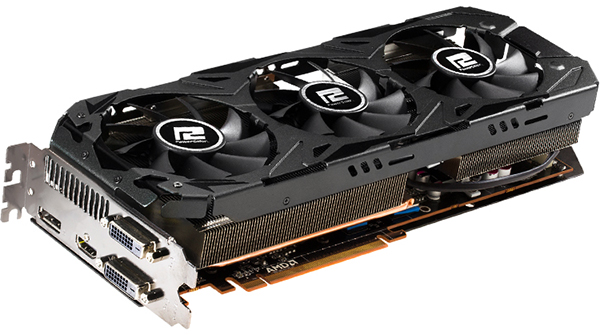
Power Color has two R9 290 cards based on a custom design. The TurboDuo R9 290, the slower of the two, is clocked at 975MHz for the GPU, while the PCS+ R9 290’s GPU runs at 1040MHz. Thanks to the custom design, the PCS+ should not have a problem of keeping its GPU clock at the maximum during extended intensive GPU load scenarios.
The R9 290 is based on the 28nm Hawaii GPU with 2560 Stream Processors. The PCS+ R9 290 comes equipped with 4GB of GDDR5 memory running at 1350MHz (5.4GHz effective).
GPUZ confirmed the PCS+ runs at 1040MHz and we can see that the GDDR5 is also factory overclocked from 1250MHz up to 1350MHz. This bumps the bandwidth up to 346GB/s, which is about 10 percent more than you’d get on a reference card, or even a reference 290X for that matter.
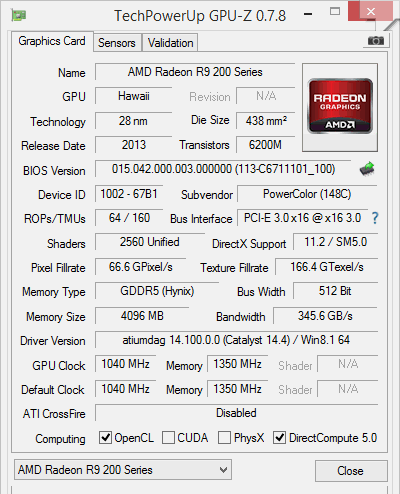
The PCS+ R9 290 box looks very nice. At the rear you’ll find some basic info about the components and the cooler, which make it clear that this is not a reference card. However we would like to see at least one image of the actual card on the box. Brick and mortar retail is still not dead and a photo would help.
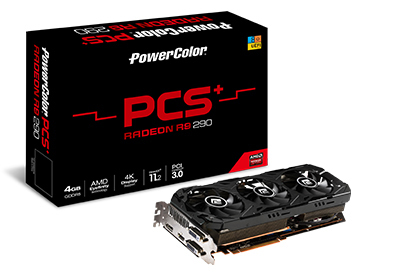
In the box you’ll find:
- Quick Installation Guide
- Driver DVD
- DVI to VGA dongle
- 6-pin to 8-pin converter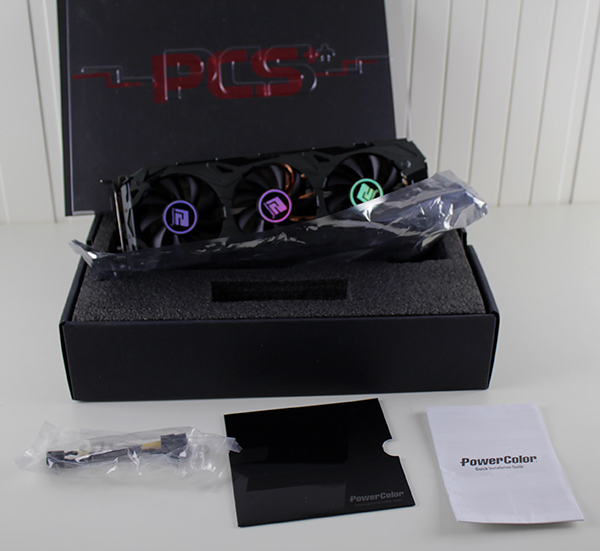
The PCS+ R9 290 looks powerful and feels promising. Once you pick it up it feels great because the shroud and the backplate are metal rather than plastic. The cooler is two and half slots wide.
The card, including the cooler, measures 295mm x 111mm x 46mm. Note this is longer than the reference design and we advise you to check whether this card fits into your case. That also makes the card rather heavy, but since it is a high-end product this is not a shortcoming. In fact, many enthusiasts still stick to the ‘heavier is better’ mantra whether they are talking about PSUs or audio components. The card weighs in at 1kg but still it is a featherweight compared to the Devil 13 HD 7990, which weighs 1.77kg, believe it or not.
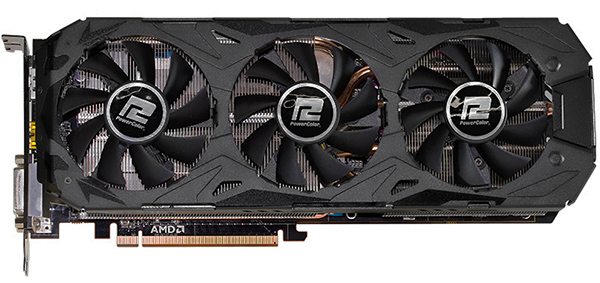
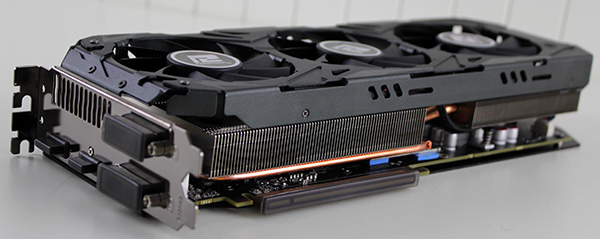
By using an oversized PCS+ cooler PowerColor wanted to make sure that the factory overclocked GPU would not throttle when it heats up. This is the case on reference R9 290X and 290 cards, which tend to drastically reduce the clock in load scenarios. The reference design features a rather problematic cooler which takes a big toll on performance, unless you manually increase the fan speed in which case it gets quite noisy and unsuitable for home use. With the reference cooler the GPU quickly heats up to 94 degrees Celsius, but AMD claims the GPU still remains within its thermal operating range. AMD didn’t go all out on the reference cooler, so the GPU can barely maintain 1000MHz on the reference R9 290X, or 947MHz on the 290 for that matter.
Thanks to its massive non-reference cooler, the PowerColor PCS+ R9 290 is immune to these issues. Although the card ships with a substantial factory overclock, it can maintain the GPU clock at 1040MHz regardless of load.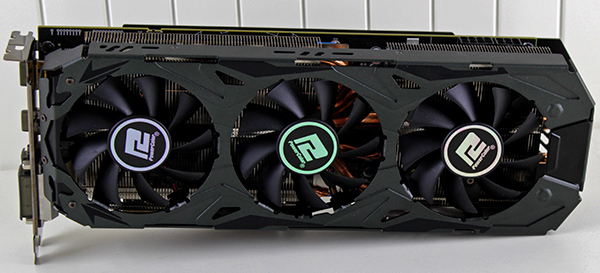
PowerColor settled on the PCS+ a three-fan cooler that might be the most powerful air cooler placed on a R9 290 card. PowerColor says that the custom cooler should reduce load temperatures by up to 24%, with a noise reduction of up to 17% compared to the reference design.
The top of the card is quite attractive. Here we see the card uses one 6-pin and one 8-pin power connector. According to AMD the reference R9 290 will draw a maximum of 275 Watts. The shroud is open on all sides and the openings serve as exhaust vents. 
Textured details, made by cutting the metal shroud, are a nice feature on the backplate. It’s a small touch, but we like it.
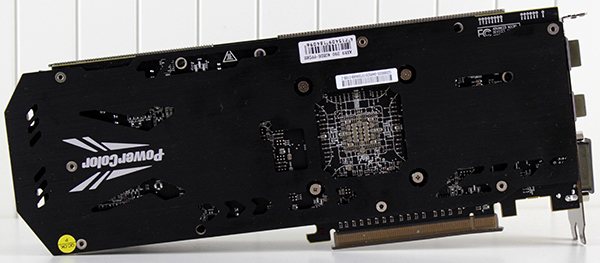
The fans take up one slot, while the heatsink takes up one and half slots. That helps create a bigger dissipation surface, but it also adds a lot of bulk. 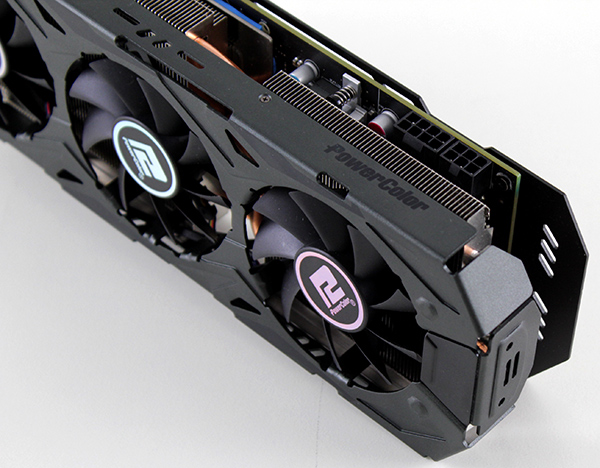
The main 10mm heatpipe is complemented by 8mm heatpipes in order to ensure maximum heat distribution, while three 75mm fans should keep the main heatsink, memory heatsink and VRM heatsing well cooled.
Fan RPM can be regulated via Catalyst Overdrive. All the fans are connected using a single 4-pin connector. PowerColor uses double bladed fans on the PCS+ R9 270 (image below), and claims the double-blade design can focus airflow into the center and increase airflow by up to 20 percent compared to traditional designs. But those are 8.5cm, lower RPM fans and unfortunately three such fans cannot be fitted on the PCS+ R9 290.
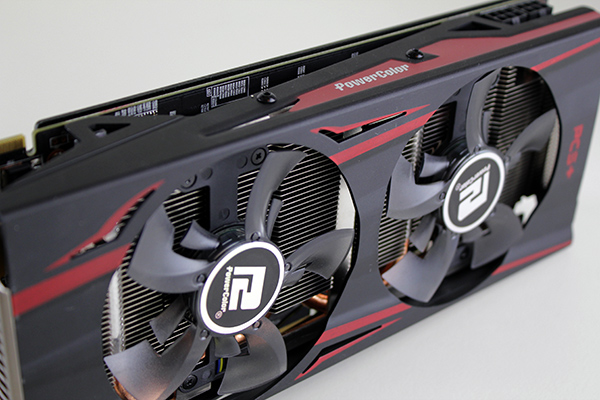
We always advise users to clean the heatsink on a regular basis. It’s good for the card and it also helps keep fan RPMs as low as possible. Accessing the heatsink is relatively easy. You can remove the shroud along with the fans simply by undoing four screws that keep them attached to the heatsink. There is no need to remove the entire cooler.
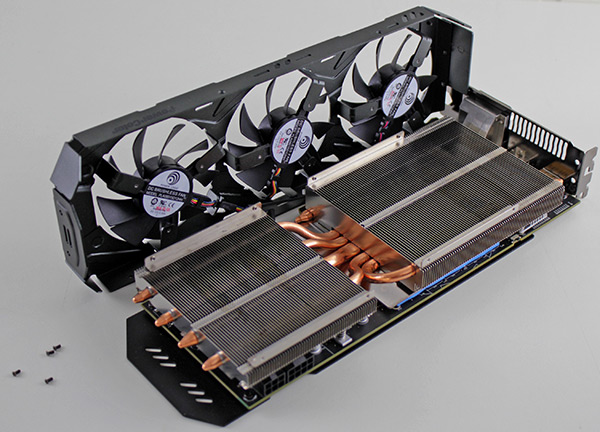
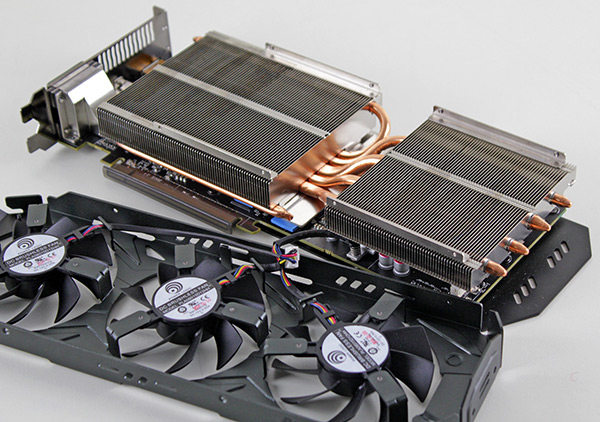
Here you can see the heatsink. Everything feels solid and very precise indeed.
The PCB is equipped with digital PWM in order to decrease ripple and enhance power efficiency. DirectFET will minimize conduction losses and the multi phase design (5+1+1) enhances power efficiency and stability. Considering the hefty factory overclock, the emphasis on tweaking the card’s power system is understandable.
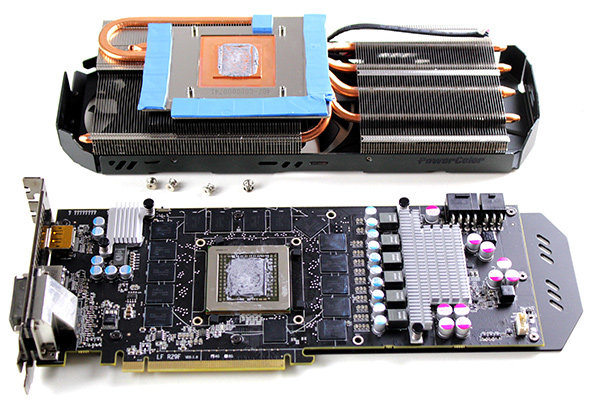
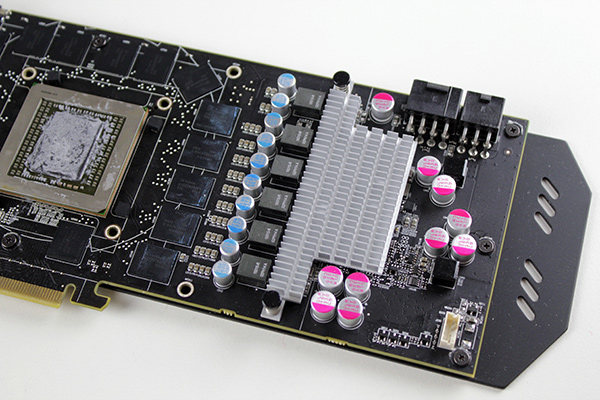
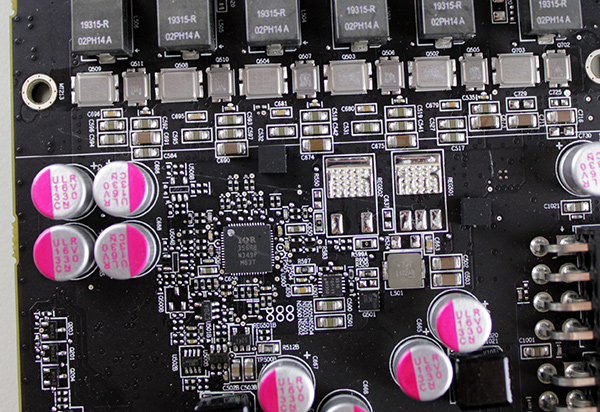
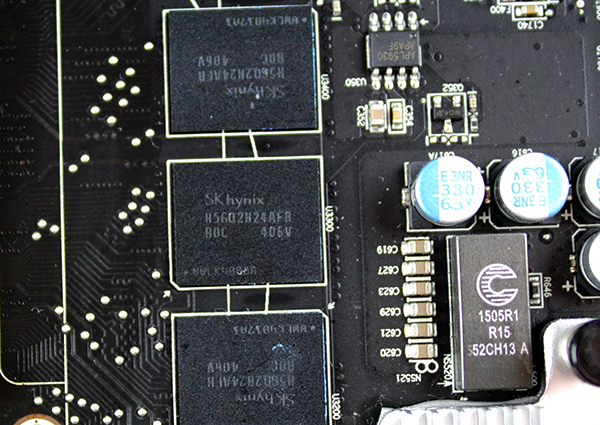
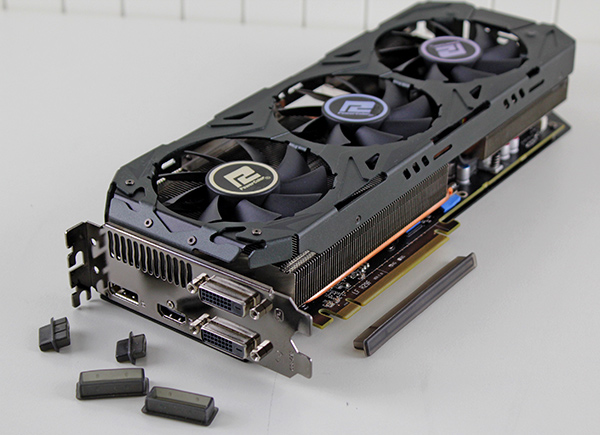
On the I/O panel you will find one standard DisplayPort, one standard HDMI and two dual-link DVI connectors. Next generation 4K (4096x2160) and UHD (3840x2160) resolutions are supported, making the card future proof to some extent. The biggest problem is the relatively high price of 4K/UHD monitors, as they are still too pricey for most gamers. On top of that, anyone willing to invest in a 4K/UHD monitor can probably afford a an even faster card.
You can also use any combination of display connectors or use four outputs at the same time. It is possible to chain up six monitors when using an MST hub. An HDMI 1.4a compatible sound device is built in the GPU, which also includes HD audio and Blu-ray 3D movies support so there is no need to connect the card to your motherboard’s/soundcard’s SPDIF out to get audio and video via HDMI.
The R9 290 lacks Crossfire connectors. AMD correctly assumes that most owners will use their R9 290 on PCI-E 3.0 motherboards that have plenty of bandwidth to ensure communication between two or more R9 290 cards. The decision to drop the connectors also saves a couple of bucks in production costs for AMD and its AIB partners. It also results in a ‘cleaner’ design with fewer points of failure.

The dual BIOS switch is used only for changing between the UEFI and standard BIOS.

Testbed:
- Motherboard: Intel DZ87KLT-75K
- CPU: Intel Core i7 4770K, 4x3.5GHz (Haswell)
- CPU Cooler: EVGA
- Memory: 2x4GB Corsair DDR3 2400MHz
- Harddisk: Corsair Neutron GTX 240GB
- Case: CoolerMaster Cosmos II
- Operating System: Win8.1 64-bit
Drivers:
- Nvidia GeForce 337.81 BETA drivers
(GTX 780 / GTX 780 Ti / GTX 780 Classified)
- AMD Catalyst 14.4 WHQL drivers
(R9 290 / PowerColor PCS+ R9 290 / R9 290X / XFX R9 290X 1000M)
Keep in mind that the PowerColor PCS+ R9 290X is a non-reference card. It ships with a high factory GPU and memory overclock, 93MHz and 100MHz respectively. Thanks to its non-reference cooler it stays relatively quiet all the time and the card did not exhibit any performance drops, which can’t be said of the reference card, as it throttles after it is placed under load.
The full performance of the reference R9 290, i.e. 947MHz for the core, comes to light only when the fan is allowed to speed up to cope with the heat. However, when fan is running at high RPMs the reference card simply gets too loud for most users.
Judging by our tests, the PCS+ cooler has a lot of potential. It manages to keep the GPU under 64 degrees Celsius in gaming tests. The reference cooler does not even come close and as long as you keep the card under load it hovers around the 94 degree mark. Note the target GPU temperature on reference R9 290 cards is set at 94 degrees Celsius.

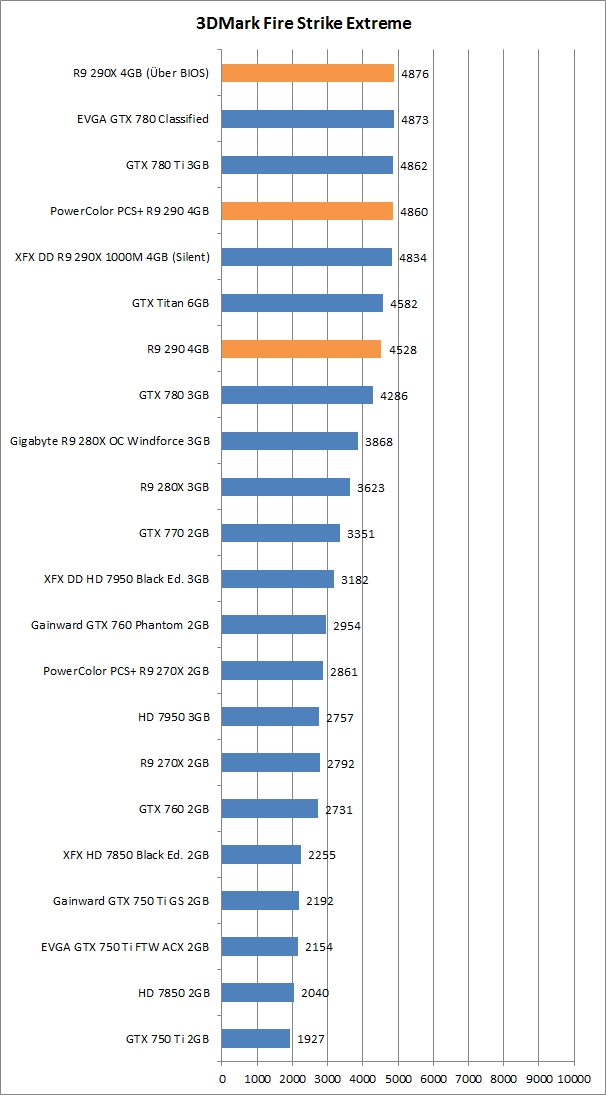
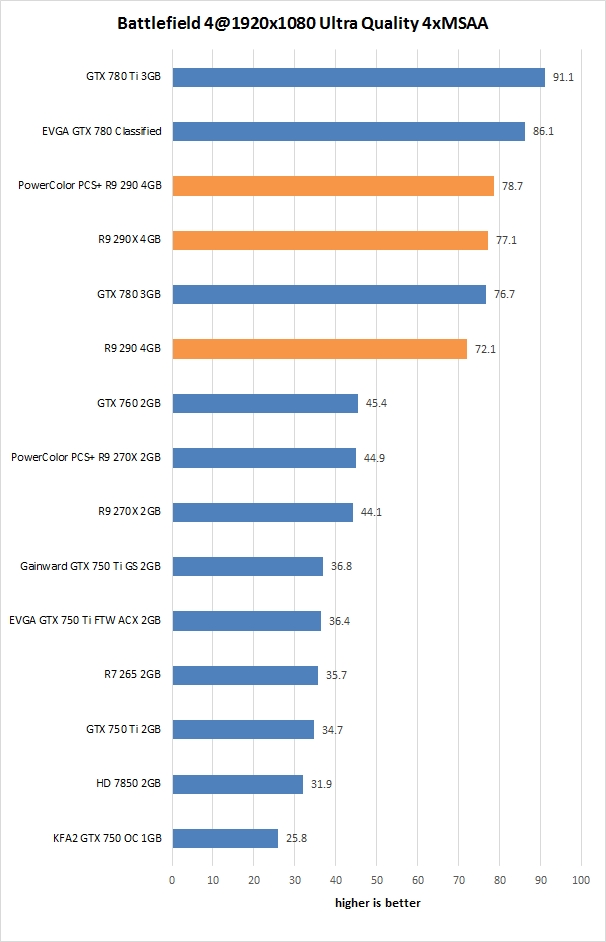
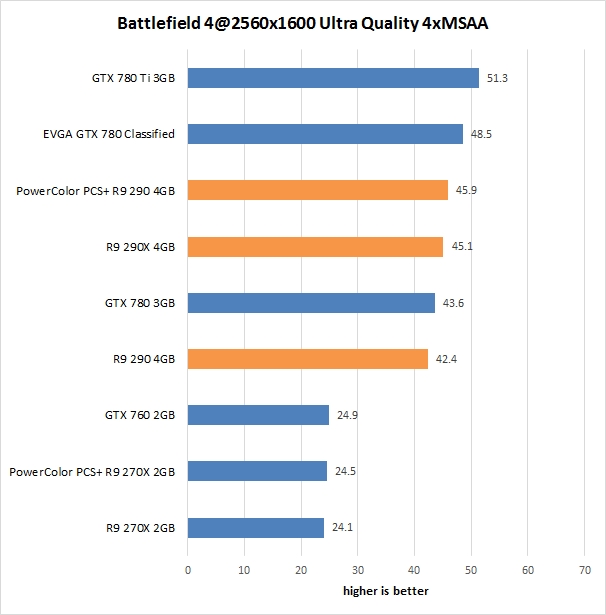
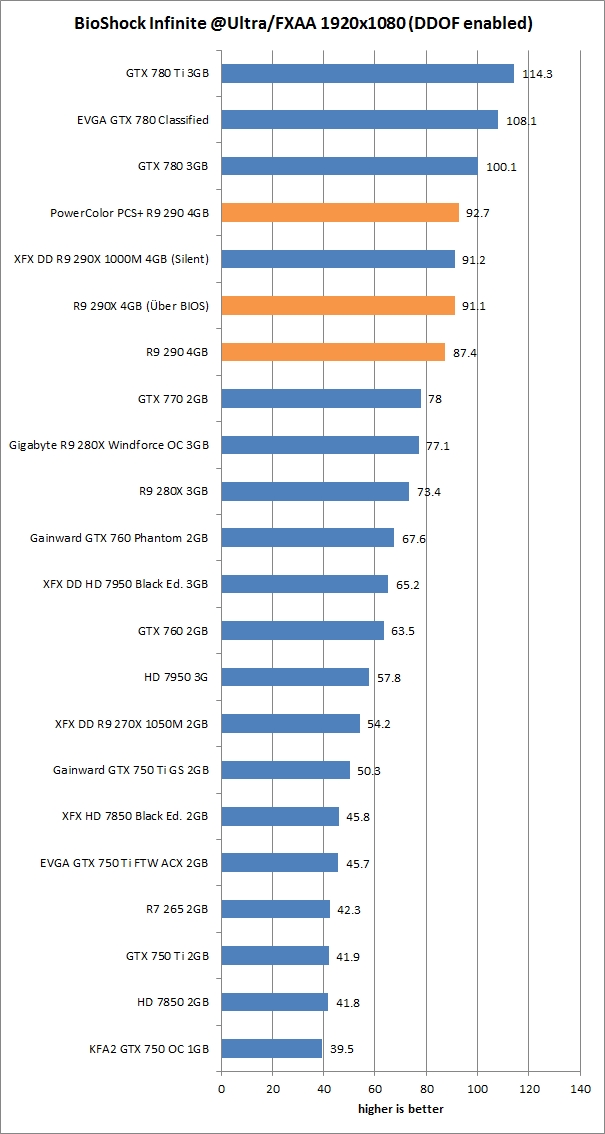
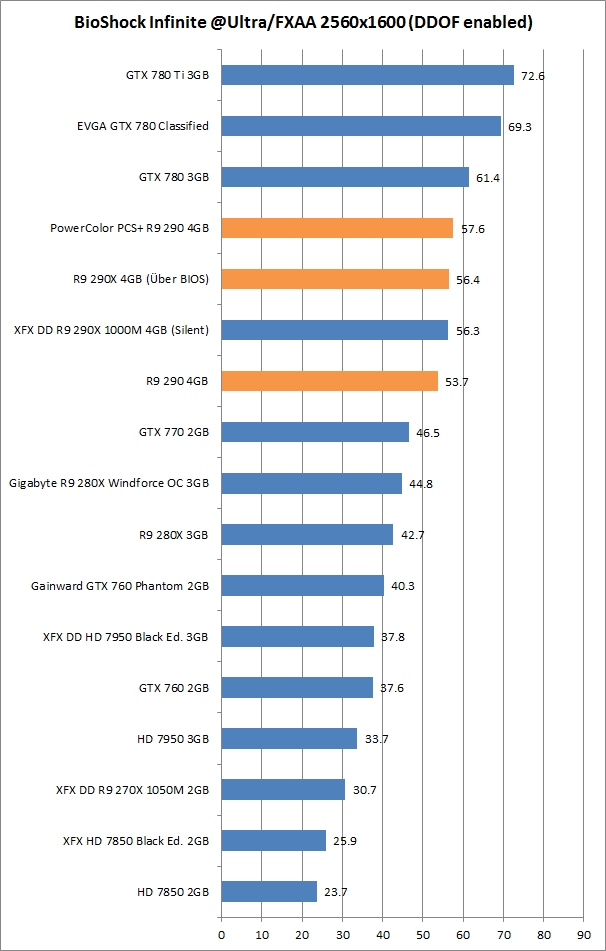
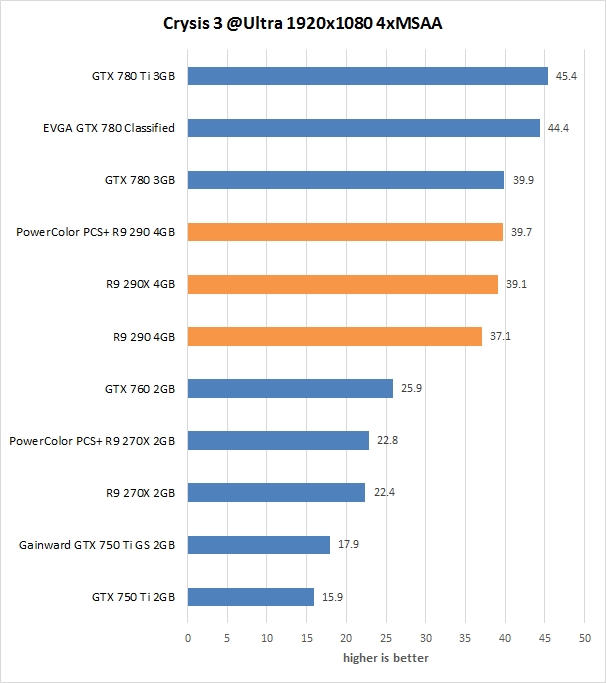
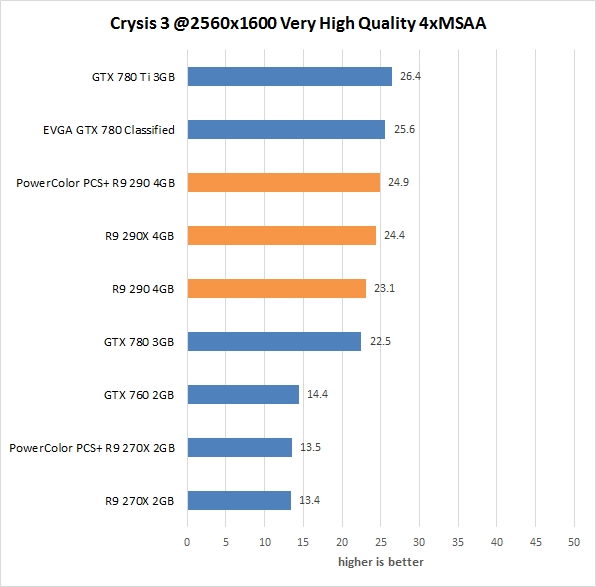
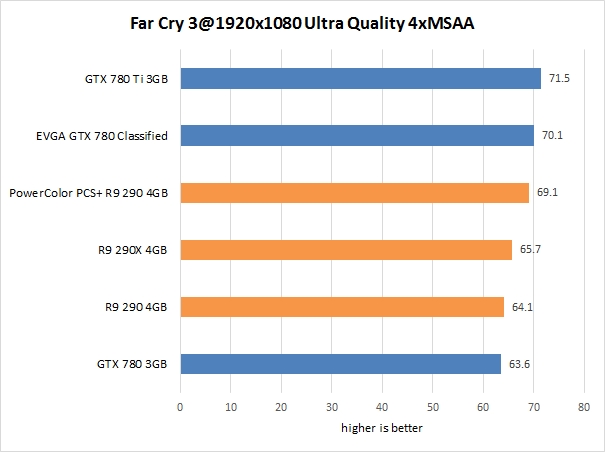
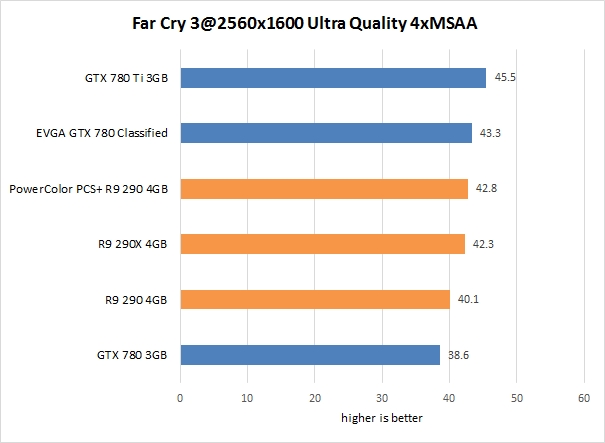
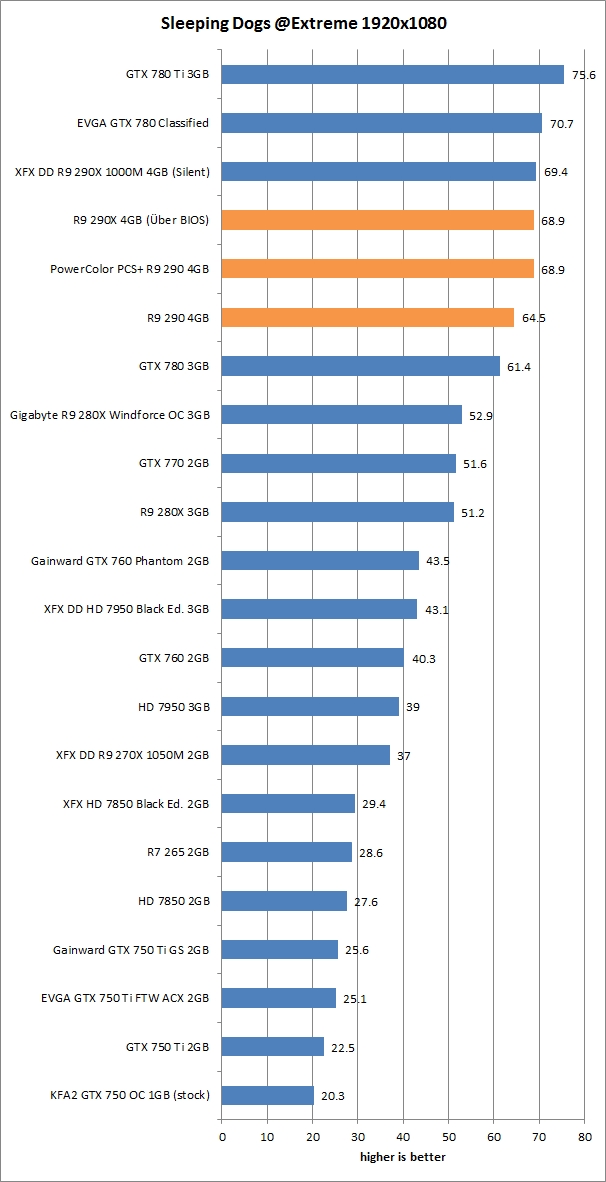
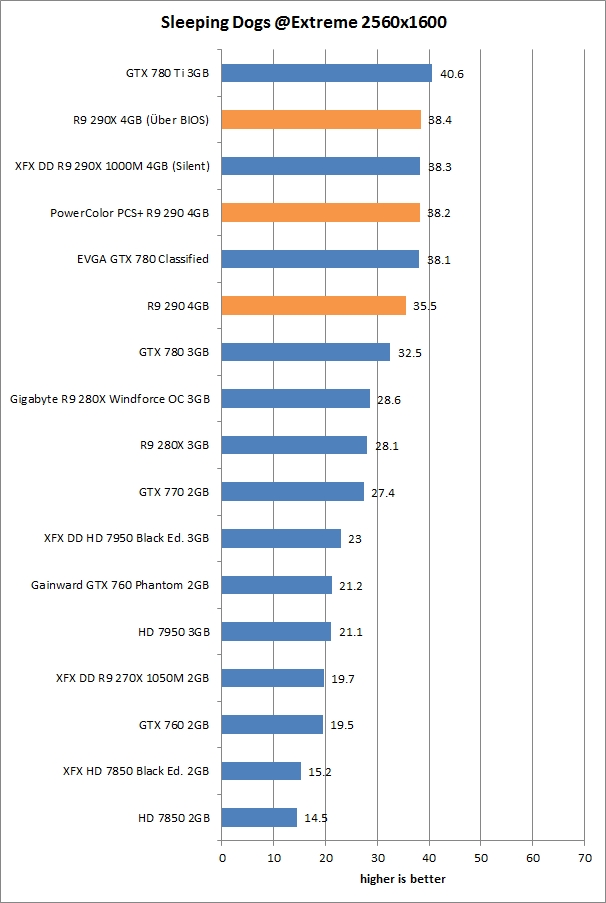
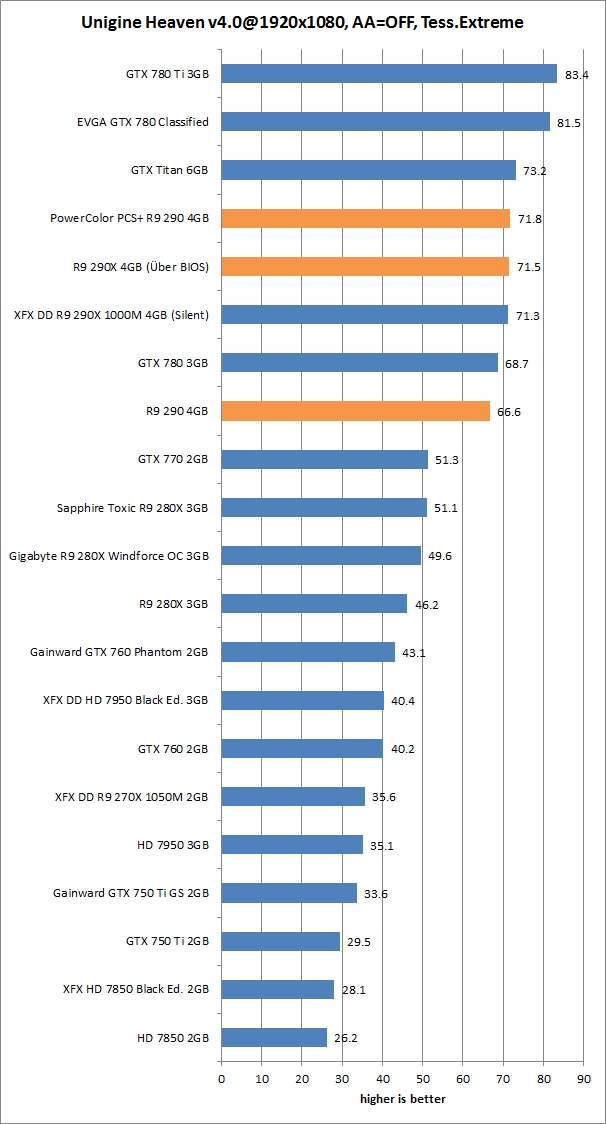
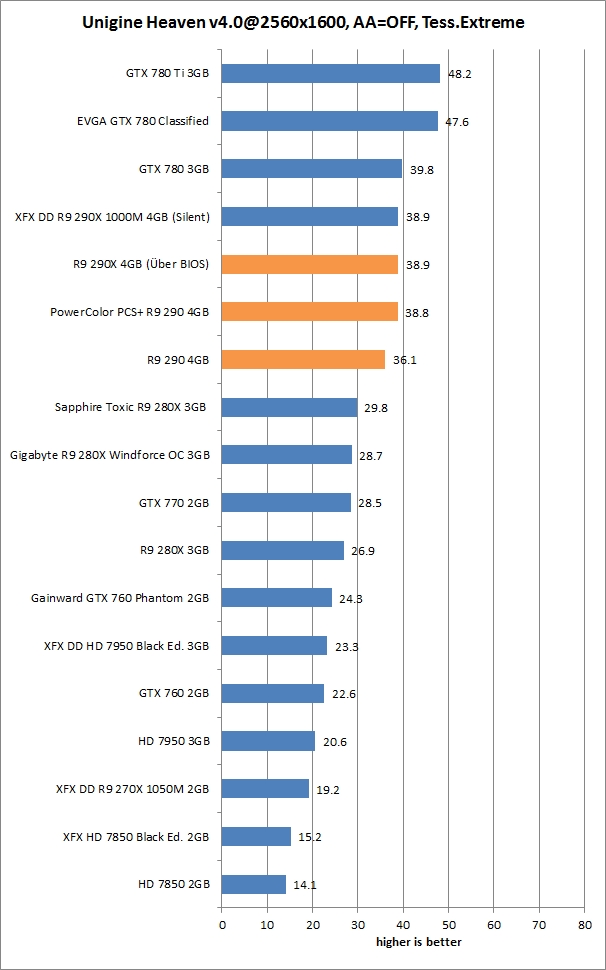
As expected the PCS+ R9 290 remains silent when it’s idling. While gaming, the noise level depends on the load, but for the most part the card stays on the quiet side. In very demanding scenes, at high resolutions like 2560x1600, the card gets a bit louder. However, even then it is quiet enough for just about any living room.
Even after a few rounds of GPU intensive benchmarks, the temperature never topped 64 degrees. Since our test bed Cosmos II chassis is spacious and well ventilated, we decided to switch off the case fans and reduce the airflow. That put a lot of strain on the PCS+ cooler, but it still performed admirably. The GPU heated up to 68 degrees and the fans spun up to 71%, or about 3000 RPM. They were audible, but not really loud. Needless to say this is a highly unlikely scenario, as every enthusiast knows that the chassis must be properly ventilated.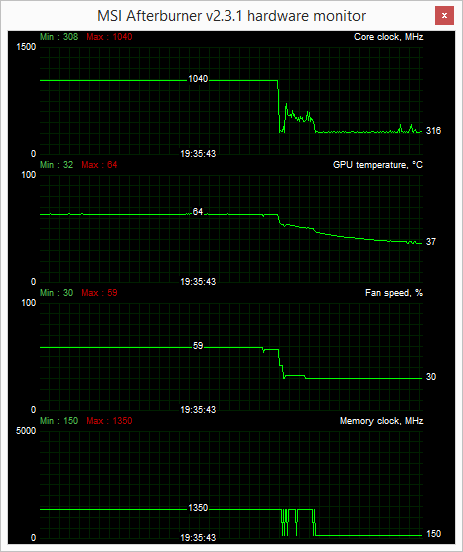
When it comes to Hawaii overlocking, the reference cooler tends to be the bottleneck. The reference PCB and GPU can handle a fair amount of overclocking, but the reference cooler cannot. Usually all it takes to unlock more performance is a decent non-reference cooler.
Thanks to the hefty cooler, the PowerColor PCS+ R9 290 card copes well with the factory overclock and it manages to maintain the GPU at 1040MHz practically all the time. That’s not all, we managed to squeeze out an additional 90MHz on top of the factory overclock. This amounts to more than a 19% boost compared to the reference clock and it’s a relatively good score.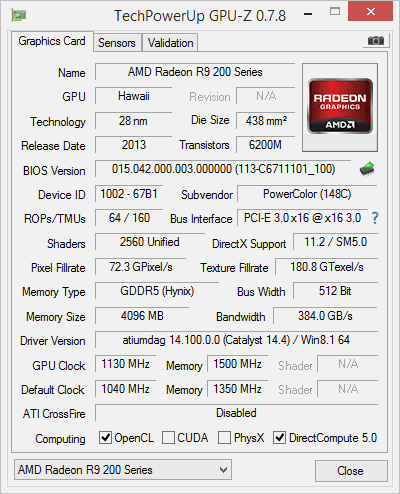
Even after overclocking, the temperature never topped 66 degrees.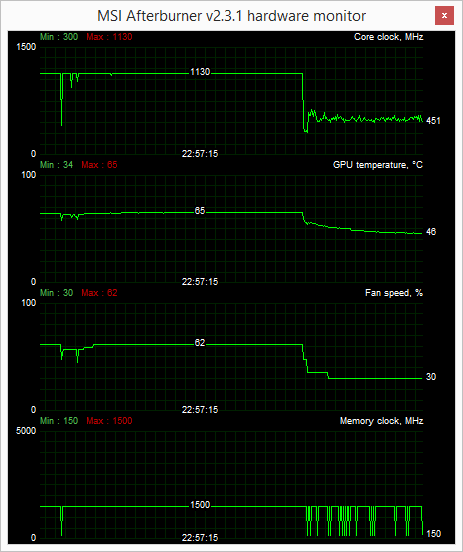
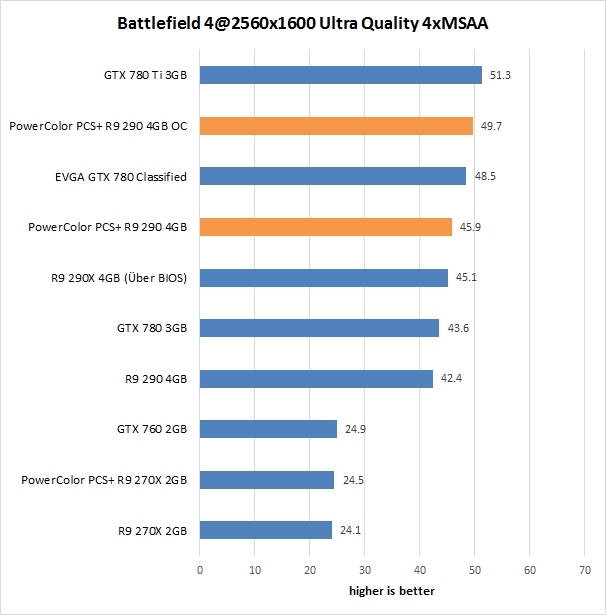
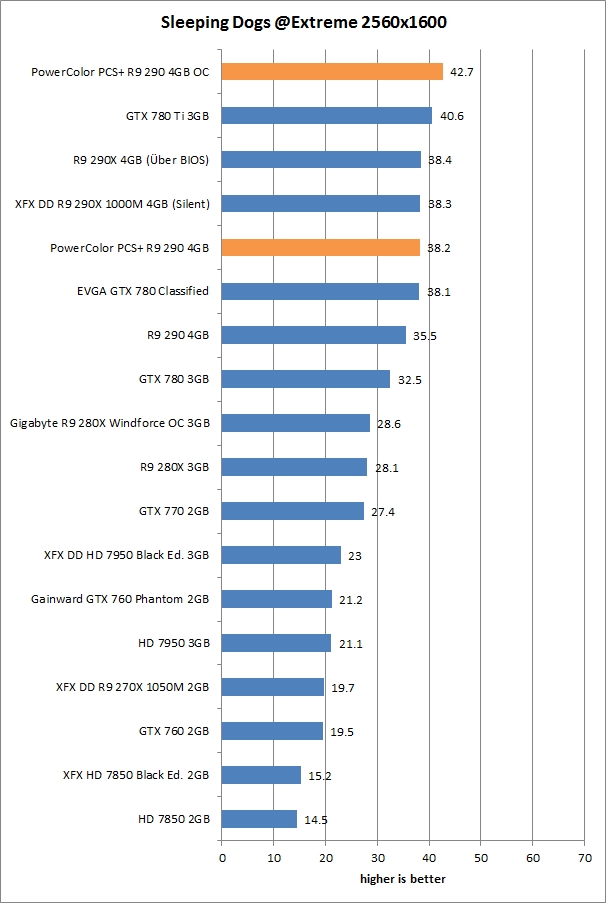
PowerColor introduced three versions of the AMD Radeon R9 290 graphics card. If you are simply looking for silence, the TurboDuo R9 290 with a dual-fan cooler is a good choice. However, if you want silence and at the same time more power and overclocking potential, we believe the PCS+ R9 290 with its massive three-fan cooler and factory overclock is a better choice. The third PowerColor R9 290 graphics card is based on the reference design and it is good if you do not care much about noise.
The PCS+ features one of the highest factory overclock among Hawaii Pro cards on the market today. The factory GPU clock stands at 1040MHz, on par with Gigabyte’s Radeon WindForce 3X, but the memory is clocked at 1350MHz, which is 100MHz faster than Gigabyte’s card. Sapphire recently introduced the R9 290 Vapor-X OC which works at 1030MHz, with the memory clock bumped up to 1400MHz. The Vapor-X cooler should be between 5 and 10 degrees cooler than Sapphire’s own Tri-X technology alone (used on the older R9 290 Tri-X OC). This puts the Vapor-X OC opportunity to compete the PCS+ at all levels. Both cards have similar clocks and should provide the same performance in games.
What we especially appreciate on the PCS+ R9 290 card is the powerful and silent cooler which maintains maximum GPU clock at all times. Note the PCS+ cooler is two and half slots wide and with its 29.5cm length it is longer than current reference high-end graphics cards. If you’re interested, make sure your chassis can handle it.
Although the 290X gets all the fame we believe Hawaii Pro products offer a slightly better price/performance ratio and with a nice custom cooler they look even more tempting. Furthermore the PCS+ R9 290 ends up about €50-70 cheaper than the R9 290X and the 290X simply does not justify the premium for many users.
New R9-series cards have better support for multiple displays than old HD 7000-series products. If you are planning to use a three-monitor setup, you no longer have to use DisplayPort for the third display. You can use two DVIs and an HDMI connector.
The PCS+ R9 290 promises excellent gaming performance, the GPU and memory are factory overclocked for additional performance out of the box and the price/performance ratio is still good. The cooler on the PCS+ R9 290 manages to provide superior cooling compared to the reference solution while keeping noise levels at a reasonable level.
To sum up, it’s a non-reference card done right, with significant improvements on all fronts, hence we’re happy to recommend it.


